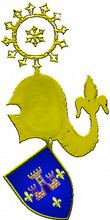Parent house Radinović | Founded 1391 (1391) | |
 | ||
Country Banate of Bosnia & Kingdom of Bosnia Estates Borač-Pavlovac
(main family estate) Titles Veliki Vojvoda Bosanski
English: Grand Duke of Bosnia
Vojvoda
English: Duke
Knez
English: Lord
Vlastelačić
English: minor Lord Style(s) Veliki Vojvoda Bosanski
English: Grand Duke of Bosnia | ||
The Pavlovići family, also Radinović or Radenović, or Radinović-Pavlović, whose ancestors Jablanići got their name after their family estate at Jablan grad (Mezgraja, Ugljevik), was a medieval Bosnian family, which ruled parts of eastern and south to southeastern medieval Bosnia. The family had their seat at Borač-Pavlovac, above the Prača canyon, between Prača, Rogatica and Goražde in Bosnia and Herzegovina.
Contents
History
Radin Jablanić was a local lord of the Krivaja valey and Prača region, and father of family's founder Pavle Radenović, who ruled a territory in the east and south to southeastern parts of the Bosnian Kingdom, from the late 14th century until his death in 1415.
Pavle Radinović plotted against then king of Bosnia, Ostoja, and his Grand Duke, Sandalj Hranić, which led to his assassination by Sandalj in Kraljeva Sutjeska in 1415, and burial in Vrhbosna.
Most prominent member of the family was Grand Duke of Bosnia, Radislav Pavlović, son of Pavle.
Family seat
The family hailed and ruled from Borač-Pavlovac. It's actually two castles rather than one, built in space of several decades (two generations) and few kilometers apart in distance from each others. These are simply known as Old Borač and New Borač or Pavlovac.
Pavlovac
The new castle of Borač is actually called Pavlovac, and is considered to be a new structure also known Novi (English: New), or Novi Grad (English: New Town). Problem exist in correct dating of its construction, but some medieval charters suggest 1392, or late 14th century, as time of its construction, during Radislav Pavlović at the family's helm.
Old Borač
However, historians are certain that another Radinović-Pavlović fortress existed, original and older Borač castle, which was built around 1244 in the 13th century and located just a few kilometers downstream the Prača river, near village Mesići, between villages of Borač i Brčigovo.
Possessions
Possessions, estates and cstles of Radinović-Pavlović family:
Family tree
Coat of arms
The subject and main reference of the book "Rodoslovne tablice i grbovi srpskih dinastija i vlastele" by group of Serbian authors from 1987, in which, among other, Radinović-Pavlović coat of arms was discussed, are Illyrian Armorials, such as Fojnica and Ohmućević. These are in significant part fictional depiction of the medieval families coat of arms.
However, according to these authors, the "Illyrian Armorials" depict the family coat of arms as a fortified city with three towers, on both the shield and the crest, with red shield and golden city on it, while the city in the crest is red, as well as the mantling with an interior of golden. The "Ohmućević Armorial" added three golden fleur-de-lis in the shield, however, that interpretation is not in line with sphragistics, and is likely to be decorative. The Pavlović family left six seals, which all have the same heraldic symbol, a tower, or fortified city. The oldest coat of arms is that of Pavle, dated to 1397, which has a fortified city with one tower. On the seals of his son, Radoslav, one has one tower (1432), the other three (1437), while Radoslav's son Ivaniš has three towers in his seal. The fortification is most likely modeled after Ragusan (today Dubrovnik) seals. This seal was likely used as the family coat of arms, despite the fact that there are no authentic complete coat of arms with shield, helmet and crest.
On the same subject other authors, like Ćiro Truhelka from 1914, and more recently Nada Grujić and Danko Zelić from 2010, and Amer Sulejmanagić from 2012, have different perspectives, from which they made different conclusions. Primarily, for them existence of the coat of arms (escutcheon, helmet and crest), created by Ratko Ivančić in 1427 and still visible at family palace in Dubrovnik, is not in dispute.
Thus, according to Croatian archaeologist Ćiro Truhelka (1865–1942) and his study "Osvrt na sredovječne kulturne spomenike Bosne" from 1914, the Illyrian Armorials, according to its "ideological-propagandic message", used the red color in the coat of arms, instead of Radoslav Pavlović's coat of arms in Ragusa which used ultramarine.
On the same line Nada Grujić and Danko Zelić, in their study from 2010, state that Radislav Pavlović's coat of arms was in gold and lapis lazuli.
Radoslav Pavlović's coat of arms at his palace in Ragusa was made by Ratko Ivančić in 1427, measuring 1,28x1,28 m.
In two stećci in Boljuni near Stolac, there are engravings of a castle with three towers, which Šefik Bešlagić used to believe belonged to members of the family. On the other hand, there is an assumption that the necropolis at Pavlovac village, in Kasindo near Sarajevo, belonged to the family, thus, the resting place of the family remains unsolved.
